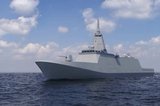Russia and Ukraine agree maritime ceasefire – then Russia attaches strings
Safe navigation in the Black Sea? A Ukrainian naval vessel in the Black Sea in 2015. (Photo: US Navy/Mass Communication Specialist 3rd Class Robert S. Price).
Russia and Ukraine agreed a maritime ceasefire following talks between Ukrainian and US delegations in Saudi Arabia on Tuesday 25 March.
The so-called “Black Sea Deal” was set out by the US, and included provisos for safe navigation in the Black Sea and an agreement to work together on measures banning strikes on energy infrastructure in both Russia and Ukraine.
The energy plant proviso echoed President Trump’s idea, expressed less than a week earlier, that the US could “run Ukraine’s energy plants” – although that plan has since been widely dismissed as “not credible”, not least by Moscow
Already have an account? Log in
Want to keep reading this article?
More from Naval Warfare
-
![NATO tests use of “undetectable, jam-proof” laser communication in maritime scenarios]()
NATO tests use of “undetectable, jam-proof” laser communication in maritime scenarios
As part of its effort to better prepare its capabilities for operations in contested and congested scenarios, NATO evaluated a Lithuanian ship-to-ship terminal designed to not be susceptible to enemy interference.
-
![Mitsubishi eyes future with Australia’s Mogami selection]()
Mitsubishi eyes future with Australia’s Mogami selection
With Australia’s selection of the Mogami-class for Project Sea 3000, Mitsubishi is investigating local production in the next decade as potential export opportunities emerge.
-
![Thales’ new Sonar 76Nano could equip UK Royal Navy on anti-submarine warfare missions]()
Thales’ new Sonar 76Nano could equip UK Royal Navy on anti-submarine warfare missions
The new sonar is designed to equip uncrewed underwater vessels, with the potential to be used by the Royal Navy for its Atlantic Bastion and Atlantic Net missions.






















